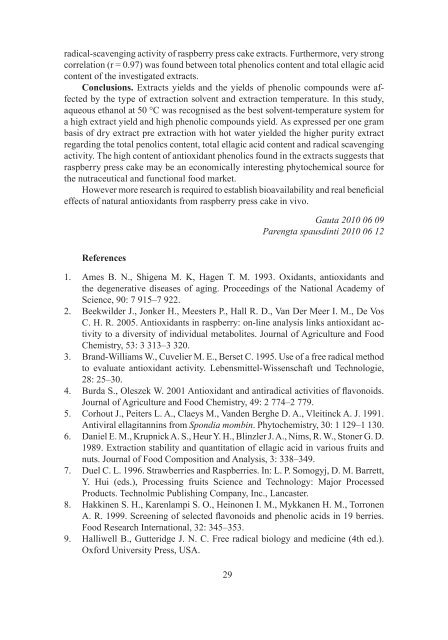Extraction of Phenolic Compounds from Raspberry Press Cake
Extraction of Phenolic Compounds from Raspberry Press Cake
Extraction of Phenolic Compounds from Raspberry Press Cake
You also want an ePaper? Increase the reach of your titles
YUMPU automatically turns print PDFs into web optimized ePapers that Google loves.
adical-scavenging activity <strong>of</strong> raspberry press cake extracts. Furthermore, very strongcorrelation (r = 0.97) was found between total phenolics content and total ellagic acidcontent <strong>of</strong> the investigated extracts.Conclusions. Extracts yields and the yields <strong>of</strong> phenolic compounds were affectedby the type <strong>of</strong> extraction solvent and extraction temperature. In this study,aqueous ethanol at 50 °C was recognised as the best solvent-temperature system fora high extract yield and high phenolic compounds yield. As expressed per one grambasis <strong>of</strong> dry extract pre extraction with hot water yielded the higher purity extractregarding the total penolics content, total ellagic acid content and radical scavengingactivity. The high content <strong>of</strong> antioxidant phenolics found in the extracts suggests thatraspberry press cake may be an economically interesting phytochemical source forthe nutraceutical and functional food market.However more research is required to establish bioavailability and real beneficialeffects <strong>of</strong> natural antioxidants <strong>from</strong> raspberry press cake in vivo.Gauta 2010 06 09Parengta spausdinti 2010 06 12References1. Ames B. N., Shigena M. K, Hagen T. M. 1993. Oxidants, antioxidants andthe degenerative diseases <strong>of</strong> aging. Proceedings <strong>of</strong> the National Academy <strong>of</strong>Science, 90: 7 915–7 922.2. Beekwilder J., Jonker H., Meesters P., Hall R. D., Van Der Meer I. M., De VosC. H. R. 2005. Antioxidants in raspberry: on-line analysis links antioxidant activityto a diversity <strong>of</strong> individual metabolites. Journal <strong>of</strong> Agriculture and FoodChemistry, 53: 3 313–3 320.3. Brand-Williams W., Cuvelier M. E., Berset C. 1995. Use <strong>of</strong> a free radical methodto evaluate antioxidant activity. Lebensmittel-Wissenschaft und Technologie,28: 25–30.4. Burda S., Oleszek W. 2001 Antioxidant and antiradical activities <strong>of</strong> flavonoids.Journal <strong>of</strong> Agriculture and Food Chemistry, 49: 2 774–2 779.5. Corhout J., Peiters L. A., Claeys M., Vanden Berghe D. A., Vleitinck A. J. 1991.Antiviral ellagitannins <strong>from</strong> Spondia mombin. Phytochemistry, 30: 1 129–1 130.6. Daniel E. M., Krupnick A. S., Heur Y. H., Blinzler J. A., Nims, R. W., Stoner G. D.1989. <strong>Extraction</strong> stability and quantitation <strong>of</strong> ellagic acid in various fruits andnuts. Journal <strong>of</strong> Food Composition and Analysis, 3: 338–349.7. Duel C. L. 1996. Strawberries and Raspberries. In: L. P. Somogyj, D. M. Barrett,Y. Hui (eds.), Processing fruits Science and Technology: Major ProcessedProducts. Technolmic Publishing Company, Inc., Lancaster.8. Hakkinen S. H., Karenlampi S. O., Heinonen I. M., Mykkanen H. M., TorronenA. R. 1999. Screening <strong>of</strong> selected flavonoids and phenolic acids in 19 berries.Food Research International, 32: 345–353.9. Halliwell B., Gutteridge J. N. C. Free radical biology and medicine (4th ed.).Oxford University <strong>Press</strong>, USA.29

















